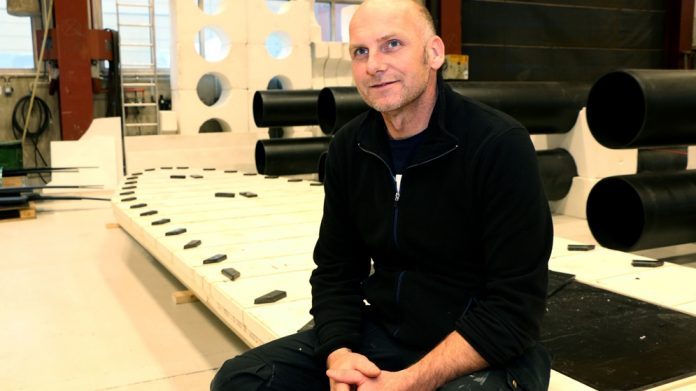We need to be thinking outside the box, thought Roger Ulriksen and suggested to completely reverse the building method for the Polarcirkel boat hulls.
The hulls of the robust Polarcirkel boats consists of resistant PE plastic, pipes included, locally produced in Mo i Rana by Helgeland Plast. With its unique buoyancy and hardy quality, PE plastic is an ideal building material for boats that are exposed to rough sea and extreme weather conditions. However, this is also a material that will expand and retract in line with temperature fluctuations, thus causing some challenges for Helgeland Plast’s boat builders.
“It’s been six years since I got the idea. Until today, fitting the pontoon, which constitutes the top of the hull, has been the first step of the construction process. We have used a lot of time adjusting and welding the frame structure from the inside of the hull. By turning it all around and building the structure first and then pressing the pontoons into place and welding it all together from the outside of the hull, there will be less need for adjustments and the welders will have a far better and less straining working posture,” explains technical drawer Roger Ulriksen.

A temporary mold has been used to build the first boat with the new technique
When the idea was born, Ulriksen worked as a welder in the production at Helgeland Plast. In 2014, the University of Tromsø’s Mo i Rana department started a new machine engineer line. Ulriksen, who already had a degree from technical colleague, seized the opportunity to expand his expertise. He considered his bachelor degree to be a great opportunity to gain acceptance for the new technique and found that the “upside down method” could give 20 percent savings on working hours related to the construction of the hull.
“What’s challenging with the method we use today, where we start off with the pontoon, is that we have many structural components that needs to fit within the pre-welded pontoons. By turning it all around, the frame set will form a rigid “skeleton” for the pontoon to rest on which means a lot less time spent on fine cutting and adjustments to make the parts fit. Fewer adjustments means shorter production time,” he explains.

The Polarcirkel boats are designed to perform safe operations in tough conditions.
The first “upside down hull” was recently completed with promising results. The company wants to build five boats using the new method and test them thoroughly on water before drawing a final conclusion as to whether or not the new building technique should be used on all boat models going forward. As for the construction team in the production hall, no one doubts that the future is upside down.
“Today, we’re standing on our knees inside the hull to weld the parts together. Now we can stand outside the hull, in a far more ergonomically correct posture, and perform the job both faster and better. As the new building technique will make the hulls more standardized, there will also be fewer adjustments in the next steps of the production,” concludes welder Mathias Aag.

